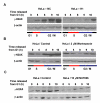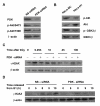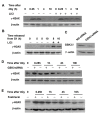DNA-PKcs plays a dominant role in the regulation of H2AX phosphorylation in response to DNA damage and cell cycle progression
- PMID: 20205745
- PMCID: PMC2844398
- DOI: 10.1186/1471-2199-11-18
DNA-PKcs plays a dominant role in the regulation of H2AX phosphorylation in response to DNA damage and cell cycle progression
Abstract
Background: When DNA double-strand breaks (DSB) are induced by ionizing radiation (IR) in cells, histone H2AX is quickly phosphorylated into gamma-H2AX (p-S139) around the DSB site. The necessity of DNA-PKcs in regulating the phosphorylation of H2AX in response to DNA damage and cell cycle progression was investigated.
Results: The level of gamma H2AX in HeLa cells increased rapidly with a peak level at 0.25 - 1.0 h after 4 Gy gamma irradiation. SiRNA-mediated depression of DNA-PKcs resulted in a strikingly decreased level of gamma H2AX. An increased gamma H2AX was also induced in the ATM deficient cell line AT5BIVA at 0.5 - 1.0 h after 4 Gy gamma rays, and this IR-increased gamma H2AX in ATM deficient cells was dramatically abolished by the PIKK inhibitor wortmannin and the DNA-PKcs specific inhibitor NU7026. A high level of constitutive expression of gamma H2AX was observed in another ATM deficient cell line ATS4. The alteration of gamma H2AX level associated with cell cycle progression was also observed. HeLa cells with siRNA-depressed DNA-PKcs (HeLa-H1) or normal level DNA-PKcs (HeLa-NC) were synchronized at the G1 phase with the thymidine double-blocking method. At approximately 5 h after the synchronized cells were released from the G1 block, the S phase cells were dominant (80%) for both HeLa-H1 and HeLa-NC cells. At 8 - 9 h after the synchronized cells released from the G1 block, the proportion of G2/M population reached 56 - 60% for HeLa-NC cells, which was higher than that for HeLa H1 cells (33 - 40%). Consistently, the proportion of S phase for HeLa-NC cells decreased to approximately 15%; while a higher level (26 - 33%) was still maintained for the DNA-PKcs depleted HeLa-H1 cells during this period. In HeLa-NC cells, the gamma H2AX level increased gradually as the cells were released from the G1 block and entered the G2/M phase. However, this gamma H2AX alteration associated with cell cycle progressing was remarkably suppressed in the DNA-PKcs depleted HeLa-H1 cells, while wortmannin and NU7026 could also suppress this cell cycle related phosphorylation of H2AX. Furthermore, inhibition of GSK3 beta activity with LiCl or specific siRNA could up-regulate the gamma H2AX level and prolong the time of increased gamma H2AX to 10 h or more after 4 Gy. GSK3 beta is a negative regulation target of DNA-PKcs/Akt signaling via phosphorylation on Ser9, which leads to its inactivation. Depression of DNA-PKcs in HeLa cells leads to a decreased phosphorylation of Akt on Ser473 and its target GSK3 beta on Ser9, which, in other words, results in an increased activation of GSK3 beta. In addition, inhibition of PDK (another up-stream regulator of Akt/GSK3 beta) by siRNA can also decrease the induction of gamma H2AX in response to both DNA damage and cell cycle progression.
Conclusion: DNA-PKcs plays a dominant role in regulating the phosphorylation of H2AX in response to both DNA damage and cell cycle progression. It can directly phosphorylate H2AX independent of ATM and indirectly modulate the phosphorylation level of gamma H2AX via the Akt/GSK3 beta signal pathway.
Figures







Similar articles
-
Protein phosphatase 6 interacts with the DNA-dependent protein kinase catalytic subunit and dephosphorylates gamma-H2AX.Mol Cell Biol. 2010 Mar;30(6):1368-81. doi: 10.1128/MCB.00741-09. Epub 2010 Jan 11. Mol Cell Biol. 2010. PMID: 20065038 Free PMC article.
-
MRE11 promotes AKT phosphorylation in direct response to DNA double-strand breaks.Cell Cycle. 2011 Jul 1;10(13):2218-32. doi: 10.4161/cc.10.13.16305. Epub 2011 Jul 1. Cell Cycle. 2011. PMID: 21623170
-
ATM is the predominant kinase involved in the phosphorylation of histone H2AX after heating.J Radiat Res. 2010;51(4):417-22. doi: 10.1269/jrr.10015. Epub 2010 Apr 24. J Radiat Res. 2010. PMID: 20448412
-
[gamma H2AX in the recognition of DNA double-strand breaks].Postepy Hig Med Dosw (Online). 2009 Feb 27;63:92-8. Postepy Hig Med Dosw (Online). 2009. PMID: 19252467 Review. Polish.
-
Cytometry of ATM activation and histone H2AX phosphorylation to estimate extent of DNA damage induced by exogenous agents.Cytometry A. 2007 Sep;71(9):648-61. doi: 10.1002/cyto.a.20426. Cytometry A. 2007. PMID: 17622968 Free PMC article. Review.
Cited by
-
Proteomic Analysis Implicates Dominant Alterations of RNA Metabolism and the Proteasome Pathway in the Cellular Response to Carbon-Ion Irradiation.PLoS One. 2016 Oct 6;11(10):e0163896. doi: 10.1371/journal.pone.0163896. eCollection 2016. PLoS One. 2016. PMID: 27711237 Free PMC article.
-
Assessment of DNA-PKcs kinase activity by quantum dot-based microarray.Sci Rep. 2018 Jul 20;8(1):10968. doi: 10.1038/s41598-018-29256-2. Sci Rep. 2018. PMID: 30030458 Free PMC article.
-
Role of PRKDC in cancer initiation, progression, and treatment.Cancer Cell Int. 2021 Oct 26;21(1):563. doi: 10.1186/s12935-021-02229-8. Cancer Cell Int. 2021. PMID: 34702253 Free PMC article. Review.
-
Multiple facets of histone variant H2AX: a DNA double-strand-break marker with several biological functions.Nucleic Acids Res. 2015 Mar 11;43(5):2489-98. doi: 10.1093/nar/gkv061. Epub 2015 Feb 20. Nucleic Acids Res. 2015. PMID: 25712102 Free PMC article. Review.
-
The NF90/NF45 complex participates in DNA break repair via nonhomologous end joining.Mol Cell Biol. 2011 Dec;31(23):4832-43. doi: 10.1128/MCB.05849-11. Epub 2011 Oct 3. Mol Cell Biol. 2011. PMID: 21969602 Free PMC article.
References
-
- Albino AP, Huang X, Jorgensen ED, Gietl D, Traganos F, Darzynkiewicz Z. Induction of DNA double-strand breaks in A549 and normal human pulmonary epithelial cells by cigarette smoke is mediated by free radicals. Int J Oncol. 2006;28:1491–505. - PubMed
Publication types
MeSH terms
Substances
LinkOut - more resources
Full Text Sources
Other Literature Sources
Molecular Biology Databases
Research Materials
Miscellaneous

